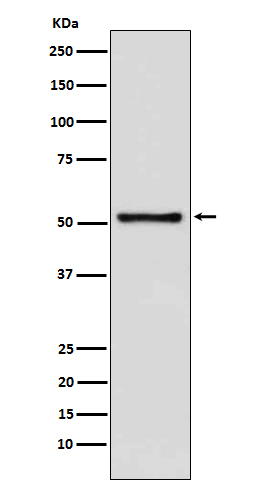
| WB | 1/500-1/1000 | Human,Mouse,Rat |
| IF | 咨询技术 | Human,Mouse,Rat |
| IHC | 1/50-1/100 | Human,Mouse,Rat |
| ICC | 技术咨询 | Human,Mouse,Rat |
| FCM | 咨询技术 | Human,Mouse,Rat |
| Elisa | 咨询技术 | Human,Mouse,Rat |
| Aliases | DNA nucleotidylexotransferase; DNTT; TDT; Terminal addition enzyme; Terminal deoxynucleotidyltransferase; Terminal transferase |
| Entrez GeneID | 1791 |
| WB Predicted band size | Calculated MW: 59 kDa; Observed MW: 59 kDa |
| Host/Isotype | Rabbit IgG |
| Antibody Type | Primary antibody |
| Storage | Store at 4°C short term. Aliquot and store at -20°C long term. Avoid freeze/thaw cycles. |
| Species Reactivity | Human |
| Immunogen | A synthesized peptide derived from human TDT |
| Formulation | Purified antibody in PBS with 0.05% sodium azide. |
+ +
以下是关于DNA Nucleotidylexotransferase(TdT)抗体的3篇参考文献(简写格式,含摘要核心内容):
---
1. **文献名称**: "Terminal deoxynucleotidyl transferase: biological studies"
**作者**: Bollum FJ
**摘要**: 该研究首次描述了TdT的生化特性及抗体开发,证实其在淋巴前体细胞中的特异性表达,为白血病诊断奠定基础。
2. **文献名称**: "Immunohistochemical detection of terminal deoxynucleotidyl transferase in acute leukemia"
**作者**: Kamps WA, et al.
**摘要**: 通过单克隆抗体检测TdT在急性白血病细胞中的表达,证明其作为T/B淋巴细胞白血病分型标志物的临床价值。
3. **文献名称**: "Terminal deoxynucleotidyl transferase in human leukemias: a flow cytometric study"
**作者**: Gorczyca W, et al.
**摘要**: 建立流式细胞术结合TdT抗体的方法,高效区分正常细胞与白血病细胞,提升微小残留病灶检测灵敏度。
---
注:TdT(末端脱氧核苷酸转移酶)是DNA Nucleotidylexotransferase的常用名称,相关抗体研究多集中于白血病诊断和淋巴细胞发育领域。如需更近期文献,建议补充关键词在PubMed等数据库检索。
DNA nucleotidylexotransferase, commonly known as Terminal Deoxynucleotidyl Transferase (TdT), is a specialized DNA polymerase that catalyzes the template-independent addition of deoxynucleotides to the 3'-hydroxyl ends of DNA during V(D)J recombination, a critical process for generating diverse antigen receptors in developing lymphocytes. TdT is predominantly expressed in immature B- and T-cell precursors, making it a valuable biomarker for identifying lymphoid progenitor cells and diagnosing lymphoid malignancies, particularly acute lymphoblastic leukemias (ALL).
Antibodies targeting TdT are widely used in research and clinical diagnostics to distinguish between mature and immature lymphoid cells. In immunohistochemistry (IHC) and flow cytometry, anti-TdT antibodies help classify leukemia subtypes (e.g., B-ALL vs. T-ALL) and monitor minimal residual disease. Their specificity for nuclear TdT expression reduces cross-reactivity with other cell types, enhancing diagnostic accuracy.
The development of TdT antibodies has advanced understanding of lymphocyte maturation and leukemogenesis. Commercially available clones (e.g., HT-6. SEN28) are validated for human and murine tissues, supporting both basic research and therapeutic applications. However, interpretation requires caution, as rare non-lymphoid tumors or activated lymphocytes may show aberrant TdT expression. Overall, TdT antibodies remain indispensable tools in hematopathology and immunology.
×